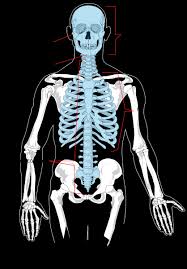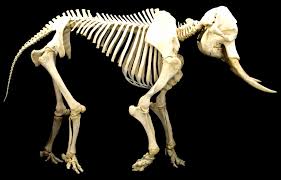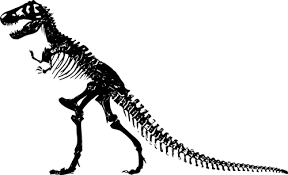Plot skeletons seem to be very popular as planning tools these days. There are all sorts of plot skeleton models out there – I counted nine different variations on Campbell’s “The Hero’s Journey” before I gave up (I have Opinions about Campbell in regard to writing); the three-, four-, and five-act structures that come out of plays; beats and plot-points; and many variations on the classic and straightforward Aristotelian “beginning, middle, end.”
All these methods are, I think, trying to codify story structure in ways that make sense to one or more individual writers. What none of them seem to start with is, do you need a plot skeleton for this sort of story:
Or this sort?
A fair number of writers I meet seem to be looking at this sort of plot skeleton and then running away:
A skeleton is what is left when you strip away the muscles, organs, and other flesh that go to make up a person or animal. It isn’t the very first thing that develops in an embryo, though it starts showing up quite early, and it changes constantly for a long time after birth (otherwise most human beings would be 20 inches tall, that being the average length of a newborn). Bones grow (sometimes in unwanted ways), replace themselves, and repair themselves when they get broken or damaged (as long as the damage isn’t too extreme or in a critical area, like one’s skull).
What does this mean for writing?
It means you don’t have to start with a plot skeleton right away (and many writers shouldn’t). Plot skeletons look like a convenient step-by-step formula for setting up a story, but every plot-skeleton-development-as-planning-tool that I’ve looked at is trying to get you to begin by designing a full-developed adult story-skeleton, not the embryonic version that is what most people need when they’re developing a story.
Worse yet, they almost all these systems assume that the writer is writing a particular kind of story – the kind that has the sort of structure they favor. This can be okay if they’re describing how to put together an elephant-story-skeleton, and you happen to be writing an elephant-story, but it doesn’t work at all if they’re talking elephants and you’re writing a Tyrannosaurus Rex. Your T. Rex bones won’t be the right sizes or shapes, and some major ones will be completely missing, and if you try to shove things in because that’s what the directions say, you’ll end up with a T. Rex with useless, top-heavy elephant tusks and … well, it just won’t work.
The catch is that when you are at the start of a story, you can often begin from either direction. That is, you can set out, consciously and deliberately, to write an elephant-story, and therefore collect only elephant-bones (incidents and scenes and ideas and plot twists) to put together into an elephant-plot-skeleton, OR you can collect whatever random bones are lying around your particular mental tar pit, and when you have a bunch, start putting together the ones that seem to match, until you have enough of them to look at and think, “Ah, this will be an elephant-story!” or “Uh-oh, this one looks like a T. Rex…”
The story and the plot skeleton depend on each other and affect each other. Sometimes, even if one starts off intending to write an elephant-story, the incidents and elements that pop up just don’t seem to fit an elephant-skeleton … until one finally has the blinding realization that one is writing an elephant seal rather than an elephant, and then everything falls into place.
Some writers need a fairly complete plot skeleton early on in their story’s development, to keep them from writing themselves into a corner or going off into the weeds somewhere. Some are really, really uncomfortable with the notion that they can change and adapt and grow whatever story-structure they started with. And some are perfectly willing to let the plot structure grow organically as they go along (and they aren’t all pantsers, either).
Ultimately, the place to start is with what you know. No writer sits down to write a book without knowing something about what they want to write and how they’re going to work, even if it’s just “I know that I have decided to write a book.” Some writers have a character; others have a setting; others have an incident or a scene that they want to explain or find out about, or an idea or theme they want to explore, or an embryonic one-sentence plot idea like “Somebody finds a library card for the Arcane Library and causes all kinds of trouble trying to learn magic from it.” Some know they want to write a thriller or a romance or a mainstream literary novel. Some know they want to write something really experimental (which can mean anything from a nonlinear multiple viewpoint book in three languages to writing a single-viewpoint first-person story because they’ve never done that before).
Once you know what it is you know, you can ask yourself “What else do I need to know?” Not what somebody told you that you should know, and not necessarily details about plot twists and what happens, just a list of things that you realize you don’t know yet that you are sure you are going to need to know, now or eventually. Then you poke at them and see what ideas show up. You pick the ones that fit together, if you are collecting random story-bones, or you pick the ideas that fit the skeleton you’re using, if one of the things you know is the sort of story you’re building.
Eventually, you have enough to go on with. “Enough” can be a two-paragraph summary for one writer and a 500-page “background bible” for another. It can also vary by book. When you have “enough,” start writing.






It might be better to think of it as a “plot scaffold.” Some writers can build a story with little or no scaffolding, but if I try that the story collapses ignominiously into a heap.
As for What I Need To Know, it is forever and always the Ending. Which is the skull of the plot skeleton; the part that give it bite. Without it, my writing attempts run around in circles and fall down dead like a T-Rex with its head cut off (or a chicken, which I understand is actually closely related to the T-Rex). And the Idea-stores, where I get my ideas, always seem to be out of stock when it comes to skulls.
(Yes, I do need more caffeine. How did you guess?)
Yes. I’ve quoted Brenda Clough’s analogy before: you have to get the python out of its cage to measure it, so you have one zookeeper grab the head and another grab the tail (good luck with that), and once you’ve done that you can send the rest of the staff in to get the rest of the snake out, stretch him to full extension, and fill in the blanks.
Right now I have the head and what looks remarkably like the tail, but I’m bogged down around where the python’s shoulder blades would be if it had any. It’ll come to me. Eventually.
I can work like that on adventures because those are more flexible than mysteries, where the clues have to trigger stuff.
There’s nothing wrong with evolving or changing your starting points, either. Years ago I came up with what I thought was a clever plot, and wrote a novelette in response.
I liked my two protagonists so much that I always had in mind to write a whole novel with them. Then I realized that I didn’t know how they had managed to get the lifestyle and professional livelihood they had in that novelette, and showing that would be a lot of fun.
The novel practically wrote itself. I’ve never had such an easy time. (I didn’t even worry about theme.) But the novelette and the novel had very different starting points.
That is close to what I do. I usually have a few bones to start with, and then I ask myself questions until I get more bones that match the feeling of the story I think I want to tell.
I keep asking myself questions about the bones I have, thus generating more bones that I assess, and then eventually I know I “have enough to go on with,” as you say.
When I imagine using a pre-existing plot skeleton, it makes me shudder and scream: “Please! No! Never!” 😉
Sometimes it isn’t the plot skeleton, but the plot guts. I’ve just hit a patch where the going is slow as molasses. I’ve hit a critical, long-anticipated scene, and there are further, also-anticipated scenes beyond that also look like they’re going to be sticky.
I don’t think I’ve got a there-is-something-I-need-to-fix or a there-is-something-I-need-to-work-out problem. I’m just stuck in the guts of a tedious fiddly bit of writing. Not quite a sagging middle, but something related. (And I may be facing a sagging middle immediately afterwards. Fun!)